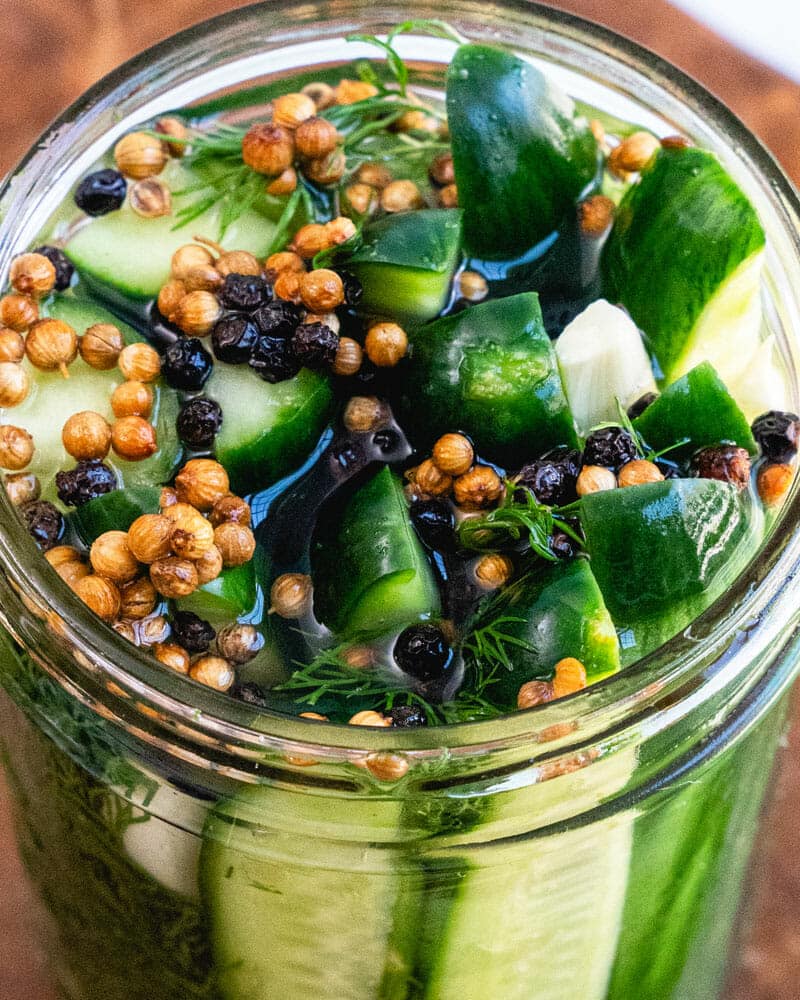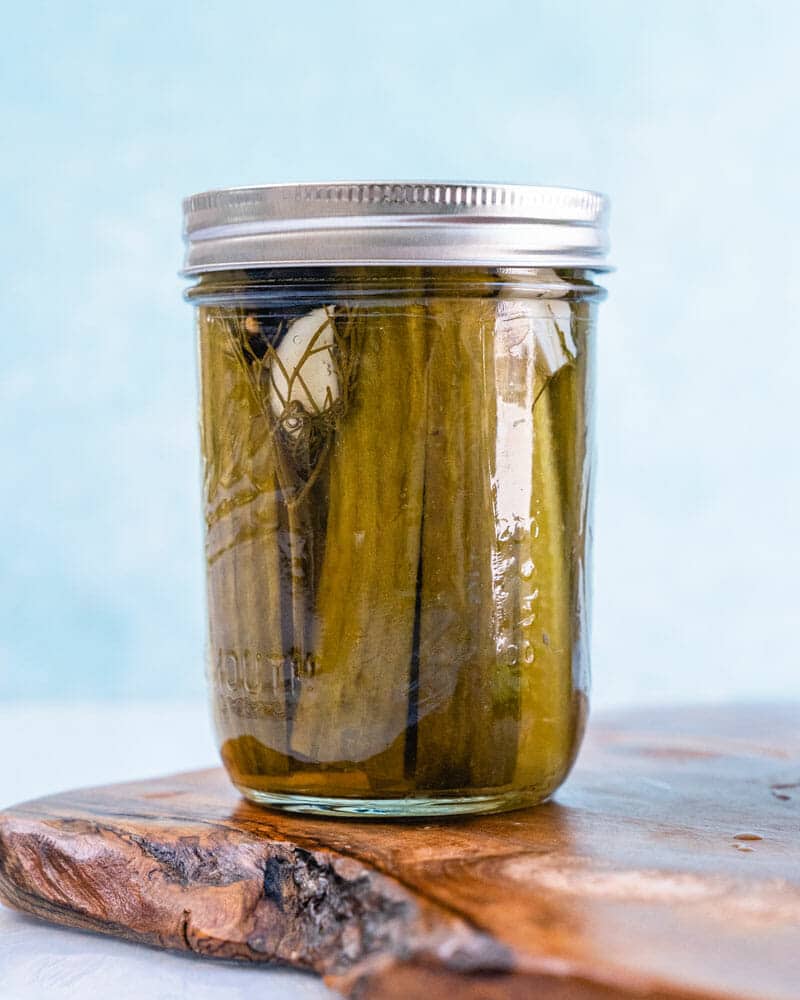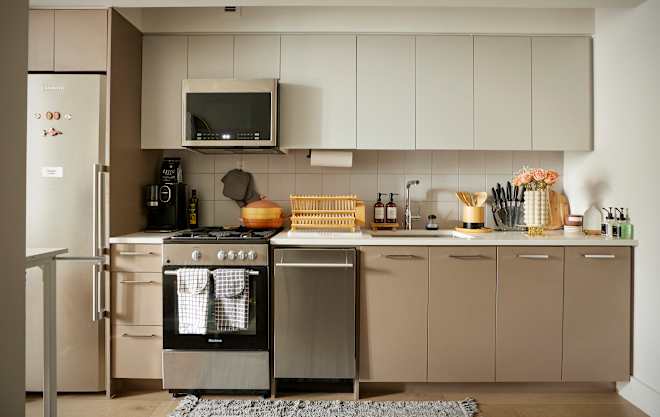How to Make Dill Pickles
Master the art of homemade dill pickles with our easy tutorial! You can make crunchy, tangy pickles in just 20…

Master the art of homemade dill pickles with our easy tutorial! You can make crunchy, tangy pickles in just 20 minutes of prep time using the refrigerator method (ready in 24 hours) or the traditional canning approach for year-round storage.

Did you know you can make homemade dill pickles in just 20 minutes? They’re tangy, salty sweet with just the right crunch—and infinitely better than store bought. As authors of two cookbooks, this is one skill Alex and I think all home cooks should know.
These pint jars of bright green spears work for lunch, dinner, snacks, and everything in between! Why make homemade pickles? They have better flavor than store-bought versions, they’re more economical than specialty pickles, you have control over the ingredients and spice levels—and it’s just plain fun! Here’s our master method for what you need to know about how to make dill pickles.
Understanding pickling methods
Traditional pickling developed as a way to preserve vegetables long before refrigeration existed. Today there are two main approaches:
- Quick pickling: A modern method using vinegar brine and refrigeration
- Traditional canning: The time-tested approach for shelf-stable preservation
Each method has its place in the modern kitchen, and your choice depends on how you plan to use your pickles and how long you need them to last. Alex and I typically use quick pickling, since it’s easier and faster.
Essential ingredients
All you need is a handful of ingredients to make this dill pickles recipe. Here are the ingredients you need for how to make dill pickles:
- Small pickling cucumbers (also called baby or Kirby). The type of cucumber for canning are small, thin cucumbers: you might see them called baby cucumbers, pickling cucumbers, or Kirby cucumbers.
- Fresh dill: We like using fresh dill in our dill pickles. If you can’t find it or prefer a look without the herb, you can also use dill seeds! Use 2 teaspoons dill seeds for this recipe.
- Peppercorns and coriander seeds: These seeds add big herby flavor.
- Garlic: Garlic adds just the right savory note.
- Salt and sugar: Brings the flavor to the pickling brine.
- White vinegar: This is what makes the pickling action happen.

Pro tips for making pickles
Successful pickling relies on creating an environment where harmful bacteria can’t thrive. The vinegar’s acidity, combined with salt, creates this preservation environment while also developing the characteristic pickle flavor. For refrigerator pickles, the cold temperature provides additional preservation. Traditional canning uses heat processing to create an airtight, shelf-stable environment. Here are a few pro tips for putting together a jar:
- Use only fresh, firm pickling cucumbers
- Cut the cucumbers uniformly for even pickling
- Make sure brine completely covers vegetables
- Use fresh spices for best flavor
- Keep cucumbers cold until ready to process
- Follow proper canning procedures for shelf-stable pickles
Method 1: Refrigerator pickles
Our favorite way to make dill pickles is refrigerator pickles! What are they and what are the pros and cons? Here’s a breakdown:
- Refrigerator pickles keep for 1 month in the refrigerator! You can eat them after 24 hours of refrigeration.
- They’re not shelf stable, but we always eat them faster than 1 month so it’s typically not a con for us.
- Refrigerator pickles are crunchy and bright green, with a crisp, tangy flavor. Processing the pickles makes them softer and milder. This is the main reason we love to make dill pickles as refrigerator pickles!

Method 2: Shelf stable pickles
For dill pickles that last up to 1 year, you can use the traditional canning method. Processing the pickles is simply boiling them for 10 minutes in a large pot. This kills all bacteria and allows them to be shelf stable for 1 year.
- You’ll need a canning rack or any rack that keeps the jars off of the bottom of the pot.
- It takes 10 minutes to boil a jar of dill pickles.
- Processed pickles are softer, sweeter and milder, with a dull green color. This is because the boiling water cooks the pickles a bit. Alex and I prefer refrigerator pickles for their flavor and color, but the shelf stable pickles are delicious too!

Ways to use pickles in recipes
Our favorite way to eat dill pickles is to snack on them out of the jar. But there are a few classic recipes that wouldn’t be the same without dill pickles. Here are a few recipes with pickles:
- Pickles add just the right briny crunch to tuna salad or egg salad
- Add them to classic potato salad
- Chop them up to give a punch to Russian dressing, aka Big Mac sauce
- A classic Bloody Mary is perfect with a dill spear.
- Add them to dill pickle dip or pickle pasta salad
Dietary notes
This dill pickle recipe is vegetarian, vegan, plant-based, dairy-free and gluten-free.
Frequently asked questions
No, always use pickling cucumbers (Kirby or baby cucumbers) for the best results. Regular cucumbers will become too soft.
Substitute 2 teaspoons dill seeds per jar. The flavor will be slightly different but still delicious.
For food safety and proper fermentation, maintain the recommended salt levels. The salt is crucial for both preservation and flavor.
How to Make Dill Pickles
Master the art of homemade dill pickles with our guide for how to create perfectly crunchy, tangy pickles in just 20 minutes of prep time! You can use the refrigerator method (ready in 24 hours), or the traditional canning approach for year-round storage.
- Prep Time: 20 minutes
- Cook Time: 0 minutes
- Total Time: 20 minutes
- Yield: 2 pint jars
- Category: Essentials
- Method: Canned
- Cuisine: American
- Diet: Vegan
Ingredients
- 2 1-pint wide-mouth mason jars with lids
- 1 1/2 to 2 pounds small cucumbers (like Kirby)
- 3 cloves garlic
- ½ tablespoon coriander seeds
- 1 tablespoon whole peppercorns
- 1 tablespoon kosher salt
- ½ tablespoon sugar
- 2/3 cup white vinegar
- 1 ⅓ cup water
- 1 large handful fresh dill (or 2 teaspoons dill seeds)
Instructions
- Wash two mason jars and lids in hot soapy water, rinse, and let air dry.
- Quarter the cucumbers into four slices lengthwise (cut off tips so they to fit inside the jar). Peel and cut the garlic cloves in half.
- In a saucepan, place the coriander seeds, whole peppercorns, sugar, kosher salt, white vinegar and water. Whisk over low heat until fully dissolved, about 1 minute, then remove from the heat.
- In the two clean mason jars, tightly pack the cucumbers, garlic and fresh dill.
- Pour the brine mixture over the cucumbers. Tap the jars on the counter to release any air bubbles and top off the jar with extra water if any cucumbers are exposed.
- Wipe jar rims dry and place the lids on the jars and screw on the rings until they are hand tight.
- For refrigerator pickles (our favorite): Leave the jars in the fridge for 24 hours before tasting. The pickles last up to 1 month in the refrigerator (they’re not shelf stable, but they never last that long!).
- For shelf-stable canned pickles: Bring a large pot of water to a boil and have a canning rack ready. Place the jars in the boiling water with the jars lifted off of bottom of pot with a canning rack (or any rack that keeps them off the bottom). Boil for 10 minutes. Turn off the heat and allow to cool in the water for 5 minutes, then carefully transfer to cutting board and allow to cool to room temperature. Check the lids for a seal after 12 hours (make sure the lids pop down: if not, store the pickles in the refrigerator like in Step 8). Store in a cool place for up to 1 year.
Types of pickles you might enjoy
Love pickles like we do? You can pickle all sorts of veggies: not just cucumbers! Here are some favorite pickles recipes:
- Our most popular pickle recipe is pickled red onions
- Make pickled jalapeños or pickled banana peppers
- Mix up uniquely delicious pickled garlic
- Try pickled carrots, pickled radishes, or quick pickled vegetables as a relish, on a cheese board or in sandwiches
- Make pickled green tomatoes or pickled okra


































































-Baldur’s-Gate-3-The-Final-Patch---An-Animated-Short-00-03-43.png?width=1920&height=1920&fit=bounds&quality=70&format=jpg&auto=webp#)



































































































































































































